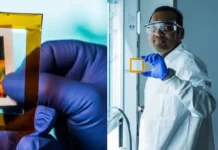
A study exploring the coupling between heat and particle currents in a gas of strongly interacting atoms highlights the fundamental role of quantum correlations in transport phenomena, breaks the Wiedemann-Franz law, and should open up an experimental route to testing novel ideas for thermoelectric devices.
From everyday experience, we know that metals are good conductors for electricity and heat—think inductive cooking or electronic devices warming up with intense use. That intimate link of heat and electrical transport is no coincidence. In typical metals, both sorts of conductivity arise from the flow of free electrons, which move like a gas of independent particles through the material. But when fermionic carriers such as electrons interact with one another, then unexpected phenomena can arise, as reported this week in the journal Proceedings of the National Academy of Sciences. Studying heat and particle conduction in a system of strongly interacting fermionic atoms, a research collaborative including Dominik Husmann of ETH Zurich found a range of puzzling behaviors that set this system apart from known systems in which the two forms of transport are coupled.
In metals, the connection of thermal and electrical conductivity is described by the Wiedemann-Franz law, which was first formulated in 1853. In its modern form, the law states that at a fixed temperature, the ratio between the two types of conductivity is constant. The value of that ratio is quite universal, being the same for a remarkably wide range of metals and conditions. That universality breaks down, however, when the carriers interact with one another. This has been observed in a handful of exotic metals hosting strongly correlated electrons. But Husmann and co-workers have now explored the phenomenon in a system in which they had exquisite control over all relevant parameters, enabling them to monitor particle and heat transport in unprecedented detail.
Clean transport
The carriers in their experiments are fermionic lithium atoms, which the researchers cooled to sub-micro-kelvin temperatures and trapped using laser beams. Initially, they confined a few hundred thousand of these atoms to two independent reservoirs that can be heated individually. Once a temperature difference between the two reservoirs was established, they opened a tiny restriction between them—a so-called quantum point contact—thus initiating transport of particles and heat (see the figure). The transport channel is defined and controlled using laser light, as well. The experiment, therefore, provides an extraordinarily clean platform for studying fermionic transport. For example, in real materials, the lattice through which the electrons flow starts to melt at high temperatures. In contrast, in the cold-atom setup, with the structures defined by light, no such ‘lattice heating’ occurs, making it possible to focus on the carriers themselves.
Read more: Breaking down the Wiedemann-Franz law
thumbnail courtesy of phys.org









